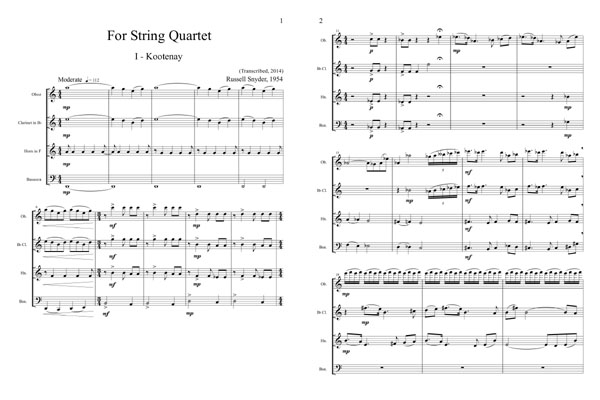

Many years ago, as an undergraduate at Wesleyan University, I wrote three somewhat extended musical compositions: a string quartet, some background music for a campus production of Shakespere's play, Much Ado about Nothing (scored for harpsichord), and a suite for string orchestra (the latter two compositions under the tutelage of Richard Winslow).
The string quartet has been performed four times, twice as a string quartet by the Wesleyan University String Quartet (at Wesleyan and at Swarthmore College), more recently as a piece for string orchestra by the Lyric Chamber Orchestra of Highland Beach, FL, (under the direction of Toronto's Victor Feldbrill), and as a string quartet by a quartet of Rogue Valley Symphony musicians (at a NACUSASOR concert in Ashland, OR). The background music accompanied a campus presentation of the play. The suite for string orchestra has never been performed.
Here is my string quartet, transcribed for oboe, clarinet, horn, and bassoon and synthesized in Finale using Garritan instruments. (The Garritan string sounds are not very realistic, so this presentation uses the more realistic wind sounds for a wind transcription of this quartet.) There are five movements, the fourth of which is quite short, essentially a bridge to the fifth movement. Note that the movement subtitles, an afterthought, were prompted by a 2013 camping trip to the Canadian Rockies.
Here are the Finale score and parts for the wind transcription, scaled to fill a 9 by 12 inch page. Left click to view .pdf versions of the original Finale (.musx) documents. You can download these .pdf documents by clicking the upper right download icon or print them directly by clicking the neighboring print icon. To print to a page size other than 9 by 12 inch, select fit to paper.
Here are the Finale score and parts for a revised version of the original string quartet, scaled to fill a 9 by 12 inch page. Instuctions for viewing, downloading, and printing are as above.
One of the privileges of retirement is that one gets to revisit his past and to imagine that whatever talents he might have enjoyed as a youth might not yet be fully spent. So it is that, despite 60 years of inactivity on this score, I have joined NACUSASOR, the Southern Oregon chapter of the National Association of Composers, USA, and seek once again to write some music.
I have begun by becoming familiar (to an extent) with Finale, a well known computer application for typesetting and processing music, entering my string quartet into this software, and using the application to transcribe the quartet for wind instruments and typeset a score and parts for both the original string quartet and its transcription for winds. I expect to use Finale to (eventually) typeset the other two works from my youth as well, and also to facilitate the production of some new music.
Just as a computer-based text editor greatly facilitates the creation of word documents (in large measure by enabling very simple but effective select, cut, and paste capabilities), so, too, does a computer-based music editor greatly facilitate the creation of music by enabling its version of select, cut, and paste and other capabilities. Of particular importance is the ability to routinely listen to a synthesized version of the evolving document, whether in part or as a whole. (For me, the creative process is very much a process of "trial and error." Being able to listen to what you have created and are creating is essential to this process.)
My initial interest is in continuing with chamber music, but branching out to instrument groups other than strings. Here is my first attempt at a new piece for wind trio and piano, Lament, created and synthesized in Finale using Garritan instruments. (Like the string quartet, this piece has been performed live at a NACUSASOR concert in Ashland, OR.)
Lament begins (and ends) with the statement of a brief (mournful) theme on English horn. This theme and an accompanying counter-theme are restated repeatedly by all wind instruments, building to a chorale-like climax and then fading away. Each of the wind instruments plays an important role in the resulting cacophony. A rudimentary piano part provides a lower register voice. The piece is dedicated to the memory of my thesis advisor at Scripps, C.S. Cox, who had recently passed away.
Here are the Finale score and parts for Lament, scaled to fill a 9 by 12 inch page. Left click to view .pdf versions of the original Finale (.musx) documents. You can download these .pdf documents by clicking the upper right download icon or print them directly by clicking the neighboring print icon. To print to a page size other than 9 by 12 inch, select fit to paper.
Score | Flute | Clarinet | English Horn | Piano | Piano Score